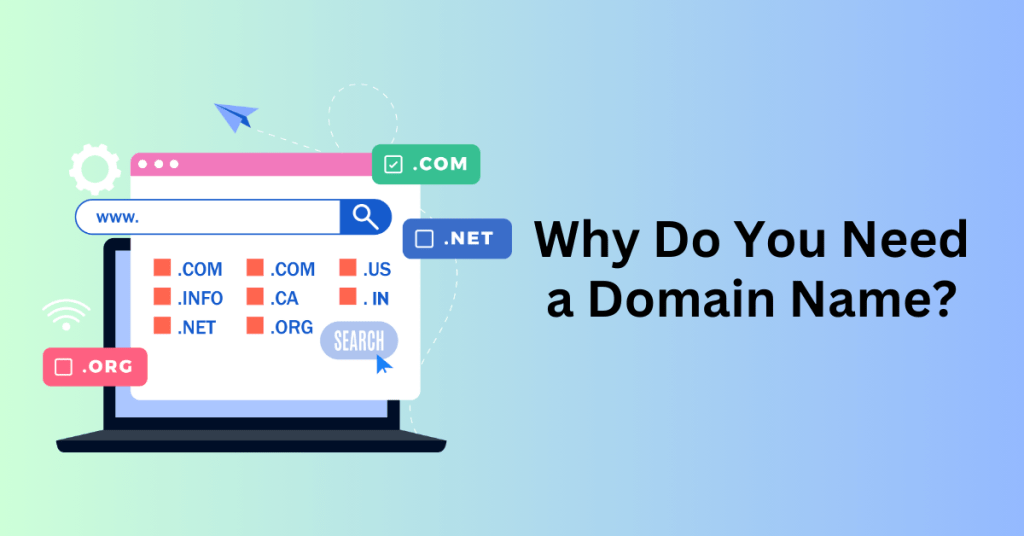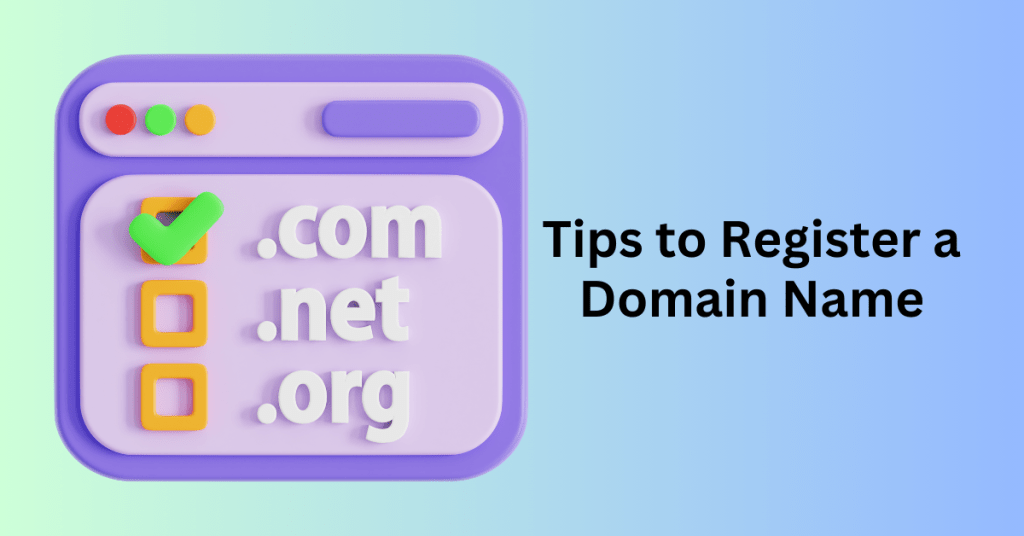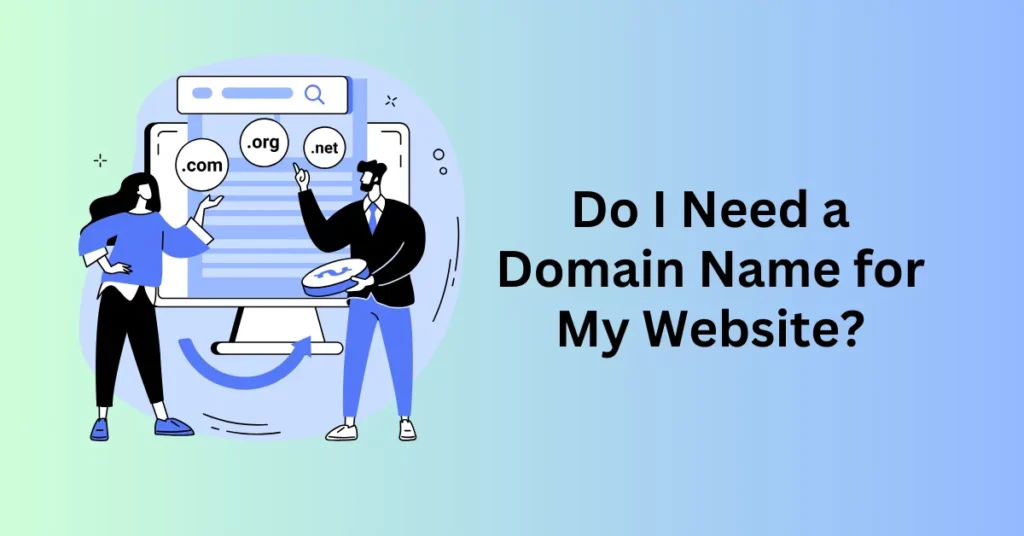There are many ways to establish an online presence. You can use third-party publishing platforms or social media networks like Facebook pages and groups. While these platforms are helpful, they don’t offer the same level of control or long-term benefits as owning your own domain name.
Whether you’re starting a personal blog, launching a business, or building a professional portfolio, securing your domain is essential. Owning a domain gives you full control over your brand and content. It allows you to design and manage your online presence according to your vision.
If you’ve ever wondered, “Why do I need a domain name?” this guide will explain why it’s a smart choice for anyone serious about building a lasting online presence.
What is a Domain Name?

A domain name is a unique and easy-to-remember web address that users enter into their browser’s search bar to visit your website. Essentially, it’s your website’s “street address” on the internet, guiding users directly to your online space. For instance, when someone types “yourbusiness.com” into their browser, it leads them to your site. Without domain names, users would have to rely on a complex string of numbers known as an IP (Internet Protocol) address to find websites, which can be hard to remember.
The Domain Name System (DNS) simplifies this process by translating these hard-to-remember numerical IP addresses into more user-friendly domain names. The DNS acts as a giant global directory. When someone types your domain name into their browser, it automatically directs them to the correct website. It functions like a smart GPS system. The DNS routes users to their online destination without requiring them to remember complex numerical codes. This system plays a crucial role in enabling seamless internet navigation, allowing users to access websites quickly and efficiently. Without DNS, the internet would be far more difficult to navigate, and online experiences would be much less user-friendly.
Securing a memorable and brand-relevant domain name is essential for businesses. It helps establish credibility and build trust with your audience. Your domain name is often the first impression visitors have of your brand. It can influence how easily potential customers find and engage with your website.
An intuitive domain name enhances brand recognition. It also plays a key role in marketing efforts, SEO (Search Engine Optimization), and overall online presence.
Components of a Domain Name
A domain name is made up of several key components, each serving a specific purpose in organizing and identifying websites on the internet. Understanding these parts can help you make informed decisions when choosing and structuring your domain.
Top-Level Domain (TLD)
The TLD, or Top-Level Domain, is the suffix that appears after the final dot in a domain name, such as .com, .net, or .org. It acts as a broad classification system for domains based on their intended purpose or geographic location. For example, .com is commonly used for commercial sites, .edu is reserved for educational institutions, and .gov is exclusive to government agencies.
Recently, a wide range of new TLDs has been introduced. These include .shop, .tech, and even country-specific TLDs like .uk for the United Kingdom or .ca for Canada. The choice of TLD can affect how your website is perceived. While .com remains the most popular for general use, niche or specialized TLDs can add relevance and distinction to your site.
Second-Level Domain (SLD)
This is the customizable, core part of your domain name that appears just before the TLD. It usually represents your business, brand, or project. In the domain “yourbusiness.com,” “yourbusiness” is the second-level domain. This portion is critical because it’s the most memorable and unique part of your domain.
Ideally, it should be short, brand-relevant, and easy to spell so that visitors can find your website without difficulty. The SLD plays a major role in branding, as it often reflects your business name or the service you provide, making it instantly recognizable to users.
Subdomain
A subdomain is an optional prefix added before the second-level domain to create a distinct web address within your main domain. Subdomains are particularly useful for organizing different sections of your website without needing to register additional domain names. For instance, you could use “store.yourbusiness.com” to direct users to your online store, while “blog.yourbusiness.com” could take them to your blog. Subdomains help segment content or services, providing a structured way to offer specialized resources (e.g., support.yourbusiness.com for customer service). This flexibility allows you to manage multiple facets of your website while maintaining brand consistency under a single domain.
Understanding the function and significance of each component—TLD, SLD, and subdomain—is crucial. This knowledge helps you create a domain structure that is both functional and aligned with your branding strategy.
Whether you’re launching an e-commerce site, a personal blog, or a corporate website, choosing the right combination of these elements is important. It can greatly impact your online presence and user experience.
How a Domain Name System (DNS) Works
When you enter a domain name into your browser, the Domain Name System (DNS) acts as an intermediary. It converts the human-readable domain name into its corresponding IP address. This conversion is essential because, while domain names are easy for people to remember, computers and servers use numerical IP addresses to communicate. The DNS system bridges this gap and directs users to the correct website hosted on a specific server.
The DNS system is crucial for the smooth operation of the internet. It allows billions of websites to remain accessible without confusion. Without DNS, users would need to remember complex strings of numbers (IP addresses) for every website they wanted to visit. This would make browsing the web much more difficult.
DNS makes the internet user-friendly by mapping easy-to-remember domain names to their respective IP addresses. This ensures a seamless flow of information and keeps websites consistently reachable. The system supports the global infrastructure of the internet, allowing users to access content from anywhere in the world with just a simple domain name.
Different Types of Top-Level Domains (TLDs)
When choosing a Top-Level Domain (TLD), it’s essential to understand that there are different types available, each serving specific purposes based on the nature of your website and target audience. Here’s a breakdown of the main types of TLDs and how they can benefit different kinds of businesses or projects:
1. Generic TLDs (gTLDs):
Generic TLDs are the most commonly used domain extensions and include familiar options like .com, .net, and .org. These TLDs aren’t associated with any specific geographic location, making them highly versatile for websites of any kind, whether personal, commercial, or nonprofit.
- .com is the most recognized and widely used, making it the go-to option for businesses looking to build a credible and universally accessible website.
- .net was originally intended for network-related entities but is now often used as an alternative to .com when the desired domain is unavailable.
- .org is traditionally used by nonprofit organizations, though it’s not restricted to them.
gTLDs are ideal for brands that want to appeal to a broad, global audience without being tied to any specific region.
2. Country-Code TLDs (ccTLDs):
Country-code TLDs are two-letter domain extensions that represent specific countries or regions, such as .co.uk for the United Kingdom, .ca for Canada, or .de for Germany. These TLDs are often used by businesses or organizations that operate within a particular country and want to build trust with a local audience.
- Using a ccTLD can signal to search engines and users that your website is relevant to a specific country, which can improve your ranking in local search results.
- It also fosters a sense of familiarity and reliability among users within that region, as they may be more inclined to trust a local domain over a generic one.
For businesses with a strong regional presence or those looking to expand into new markets, ccTLDs are an effective way to tailor their online identity to a particular demographic.
3. Specialized TLDs:
In recent years, a wide array of new, specialized TLDs has emerged, catering to specific industries or interests. These TLDs include extensions like .shop for e-commerce stores, .tech for technology-related businesses, and .bio for personal or biographical websites.
- Specialized TLDs provide an excellent opportunity for businesses to highlight their niche and make their domain more memorable. For example, a company focused on health and wellness could opt for a .health TLD, or a photographer might choose .photography to emphasize their craft.
- These TLDs can enhance your branding efforts, making your website stand out from the competition while giving users an immediate understanding of your website’s purpose.
Although these TLDs may not have the universal recognition of .com, they offer creative flexibility and a chance to convey your website’s specific focus instantly.
Many businesses still gravitate toward .com because of its universal recognition and association with professionalism. However, depending on your industry or goals, you might consider one of the many creative TLD options now available. Choosing a specialized or regional TLD can help your brand stand out. This is especially useful if the perfect .com domain is already taken or if you’re targeting a specific market or niche. By aligning your domain extension with your brand’s identity, you can create a lasting impression on your target audience. This also ensures that your website remains accessible and relevant to the people who matter most.
Why Do You Need a Domain Name?

Owning a domain name isn’t just for businesses—it’s a valuable asset for individuals as well, whether you’re a freelancer, creative professional, or hobbyist. Here are five compelling reasons why individuals should secure their own domain name:
1. Establish Your Personal Brand with Custom Domain Name
A domain name is a powerful tool for building a personal brand that reflects your unique identity. Instead of relying on third-party platforms, a custom domain like “bennietay.com” provides a professional space to showcase your talents, skills, or hobbies. Whether you’re a writer, designer, photographer, or entrepreneur, a custom domain helps you create a polished and cohesive brand presence online. It sets you apart from others in your field. It also gives you the freedom to define and evolve your brand as you grow.
2. Control Your Online Presence with Custom Domain Name
Owning your domain puts you in the driver’s seat of your online presence. You have full control over how your website looks, the content you display, and how your brand is presented. Unlike free platforms, which often limit customization and branding opportunities, having your own domain allows you to build a website that aligns with your personal vision and goals.
Whether you want a sleek portfolio, an engaging blog, or a professional landing page, a custom domain ensures that your online presence reflects exactly what you want it to.
3. Make a Memorable Impression with Custom Domain Name
A custom domain name is far more memorable than a generic, cluttered URL from a free platform. For example, “bennietay.com” is much easier for visitors to remember than something like “thirdpartyplatform.com/bennietay123.” A personalized domain name not only boosts your credibility but also makes it more likely that visitors will return to your site.
Whether you’re using it for a portfolio, blog, or side business, a memorable and professional web address leaves a lasting impression, increasing your chances of growing an audience or attracting new opportunities.
4. Secure Your Online Identity for the Future with Custom Domain Name
Even if you’re not ready to build a full website right away, securing your domain name is a wise investment in your future. As the internet expands, desirable domain names are quickly being claimed. Reserving your own name or brand ensures it will be available when you’re ready to use it.
By locking in your domain now, you protect your personal brand from being used by others. This includes preventing impersonation or unrelated ventures. This simple step can save you from potential headaches and gives you peace of mind that your online identity is secure.
5. Enhance Credibility and Professionalism with Custom Domain Name
Whether you’re job hunting, pitching to clients, or showcasing your work, a personalized domain offers a level of professionalism and credibility that a free platform simply can’t match.
A custom domain shows potential employers, clients, or collaborators that you’re serious about your craft. It signals that you’re committed to presenting your work in a professional and organized manner.
In competitive industries, having a personalized domain gives you an edge by making you appear more polished and authoritative. Additionally, a professional website with a custom URL is a great way to demonstrate your skills, creativity, and attention to detail.
Why Your Business Needs a Domain Name
For businesses, owning a domain name is a fundamental step toward establishing a strong online presence. It’s more than just having a web address—it’s about cultivating trust, credibility, and visibility in the digital marketplace. Here are five compelling reasons why every small business should invest in its own domain name:
1. Boost Credibility and Trust
A custom domain, like “yourcompany.com,” instantly signals professionalism and legitimacy. Customers are more likely to trust a business that has its own branded domain rather than one using a free platform with a subdomain like “yourbusiness.thirdpartyplatform.com.” A personalized domain reassures visitors that your business is well-established, credible, and trustworthy. It communicates that you’re serious about your online presence, which can lead to increased confidence in your products or services.
2. Enhance Search Engine Visibility
Search engines, such as Google, favour websites with custom domain names when determining search rankings. Having your own domain name can enhance your SEO (Search Engine Optimization) efforts, making it easier for customers to find you online. A custom domain not only improves search engine rankings but also gives your business an authoritative presence on the web. This increased visibility drives more traffic to your site, which can translate to more leads, sales, and customer engagement.
3. Professional Email Addresses
With a custom domain, you can create branded email addresses like “info@yourcompany.com” or “support@yourcompany.com.” Professional email addresses enhance your brand’s credibility and are much more memorable than generic ones like Gmail or Yahoo accounts. Not only do they make your business look more polished and professional, but they also help build trust with customers, clients, and partners. Custom email addresses provide a unified brand experience, reinforcing your business identity in every communication.
4. Full Control of Your Website
Owning your domain gives you full control over your website’s content, design, and functionality. You’re not dependent on third-party platforms, which often come with restrictions or limitations on customization. If a platform changes its terms of service, policies, or even shuts down, businesses using their own domain remain unaffected. This ensures that your website—and therefore your business—always has a stable and independent presence online.
Besides, it also gives you the flexibility to expand or redesign your site as your business grows, without being constrained by someone else’s platform.
5. Stand Out from Competitors
In a crowded marketplace, a custom domain helps your business stand out from competitors. A domain name that clearly reflects your business, like “bestbakeshop.com” or “proplumbingservices.com,” is more memorable and distinctive than a generic subdomain. It demonstrates that you’re serious about your brand. This can influence potential customers when they choose where to spend their money.
A well-chosen domain name also strengthens your branding efforts. It makes it easier for people to recognize, remember, and return to your website.
Tips to Register a Domain Name

Choosing the right domain name is a vital step in building a strong online presence. A well-chosen domain can help you attract visitors, improve your SEO, and establish your brand. Here are some expanded tips to guide you through selecting the perfect domain name:
1. Keep It Simple
Simplicity is key when it comes to domain names. The name should be easy to remember, type, and share. Shorter, more straightforward names are less prone to spelling errors, and they’re easier for people to recall. Ideally, aim for one or two words that clearly reflect your brand or business. For example, a domain like “bennietayhosting.com” is more user-friendly and memorable than a complicated one like “the-best-web-design-hosting.com.”
Avoid adding unnecessary words, numbers, or symbols that could confuse visitors. If your ideal domain name is already taken, consider making slight variations, but be cautious about making it overly complex. If your first-choice domain name is unavailable, try adding a relevant word or considering variations, but always prioritize simplicity.
2. Include Keywords
Incorporating relevant keywords into your domain name can improve your search engine rankings. Keywords help both search engines and users understand what your website is about. For example, if you’re a hosting services provider, a domain like “besthostingsolutions.com” gives users an immediate sense of your business while improving your chances of ranking higher in search results.
However, avoid overstuffing the domain with too many keywords. The focus should be on making the name natural and brand-centric. An overly keyword-heavy domain can come across as spammy and hurt your credibility. You may use tools like Google Keyword Planner to research high-ranking keywords that might align with your business and domain name. Keep a balance between SEO and branding to create a domain that works for both.
3. Avoid Special Characters
Steer clear of using numbers, hyphens, or other special characters in your domain name. They can be easily mistyped or forgotten by users, leading to confusion and missed traffic. For example, “webdesign4all.com” or “web-design-services.com” might confuse users compared to a simpler alternative like “webdesignl.com.”
When users forget where to place a hyphen or omit a number, they might end up on a different website. Using only letters in your domain makes it more user-friendly and reduces the chances of errors.
If your brand name includes a number or hyphen, consider registering both versions of the domain—one with special characters and one without. This ensures that visitors can still find you, even if they mistype the address.
4. Choose the Right TLD (Top-Level Domain)
While .com is the most common and trusted TLD, it’s not the only option. Depending on your industry or target audience, you might choose a more specific TLD that better reflects your business. For example, if you run an eCommerce site, .shop might be an ideal choice, while tech companies can use .tech, and creative professionals might opt for .design.
Using an industry-specific TLD can give visitors an immediate understanding of what your business offers before they even visit the site. However, because .com remains the most widely recognized and trusted, it’s still worth prioritizing if it’s available.
However, you can also keep an eye out for new and emerging TLDs that align with your niche, like .co, .blog, or .app. These options can help you stand out in a crowded market.
5. Register Similar Domain Name
To protect your brand, consider registering multiple variations of your primary domain name. For example, if you own “yourbusiness.com,” you might also want to secure “yourbusiness.net” or “yourbusiness.co” to prevent competitors or others from using similar domains. This strategy safeguards your brand, especially as your business grows and becomes more recognizable.
Additionally, if your domain name contains a word that’s commonly misspelled, consider registering those variations too. This ensures that visitors who mistype your domain still end up on your website. For example, if your brand name is “ColourfulShirts.com,” you might want to register “ColourfulShirts.com” as well.
Securing your domain on multiple TLDs and common misspellings can also protect against cyber-squatting, where someone buys up similar domain names to profit by selling them back to you at a higher price.
Final thoughts: Do I Need a Domain Name for My Website?
In conclusion, a domain name is more than just an address for your website—it’s a vital component of your online identity. Whether you’re launching a personal blog, starting a business, or building a professional portfolio, securing a domain name enhances your credibility, boosts your SEO efforts, and ensures you stand out in a crowded digital landscape. It provides a level of professionalism and control that free platforms simply can’t match. Investing in your own domain now not only protects your brand but also sets the stage for future growth. If you’re serious about creating a lasting and impactful online presence, securing your domain name is a crucial first step.


